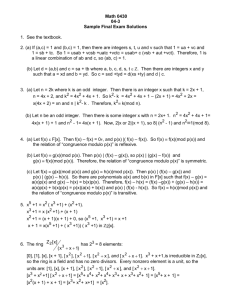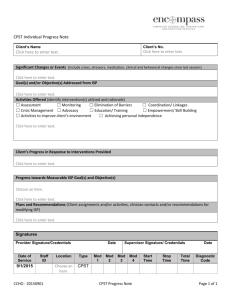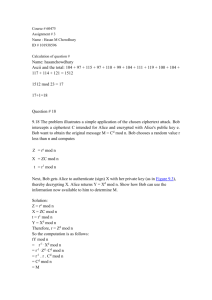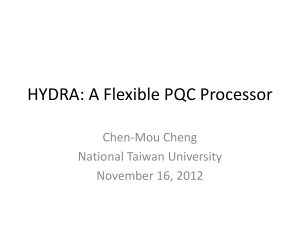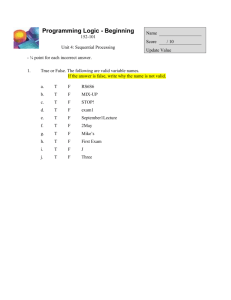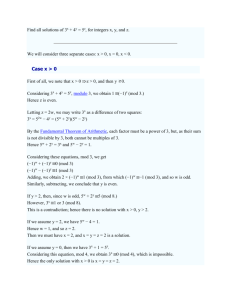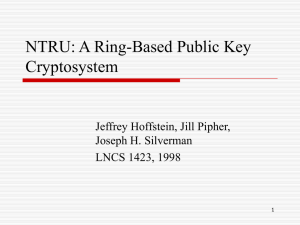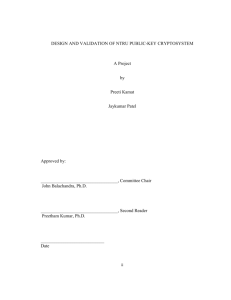f*M (mod p)
advertisement
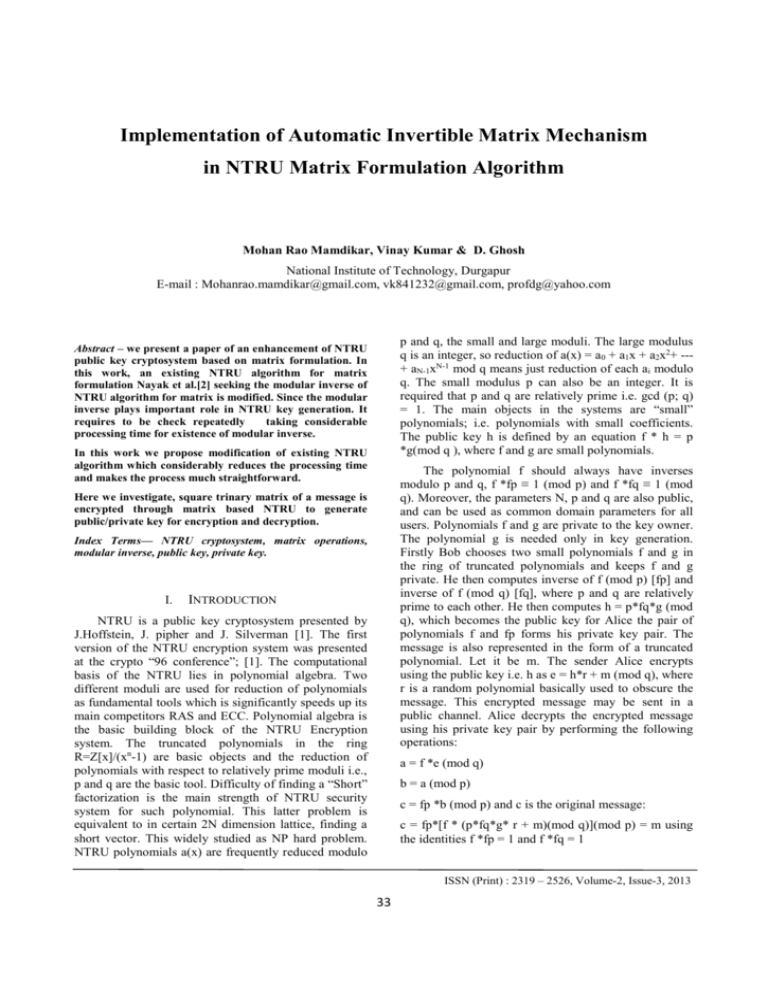
Implementation of Automatic Invertible Matrix Mechanism
in NTRU Matrix Formulation Algorithm
Mohan Rao Mamdikar, Vinay Kumar & D. Ghosh
National Institute of Technology, Durgapur
E-mail : Mohanrao.mamdikar@gmail.com, vk841232@gmail.com, profdg@yahoo.com
p and q, the small and large moduli. The large modulus
q is an integer, so reduction of a(x) = a0 + a1x + a2x2+ --+ aN-1xN-1 mod q means just reduction of each ai modulo
q. The small modulus p can also be an integer. It is
required that p and q are relatively prime i.e. gcd (p; q)
= 1. The main objects in the systems are “small”
polynomials; i.e. polynomials with small coefficients.
The public key h is defined by an equation f * h = p
*g(mod q ), where f and g are small polynomials.
Abstract – we present a paper of an enhancement of NTRU
public key cryptosystem based on matrix formulation. In
this work, an existing NTRU algorithm for matrix
formulation Nayak et al.[2] seeking the modular inverse of
NTRU algorithm for matrix is modified. Since the modular
inverse plays important role in NTRU key generation. It
requires to be check repeatedly
taking considerable
processing time for existence of modular inverse.
In this work we propose modification of existing NTRU
algorithm which considerably reduces the processing time
and makes the process much straightforward.
The polynomial f should always have inverses
modulo p and q, f *fp ≡ 1 (mod p) and f *fq ≡ 1 (mod
q). Moreover, the parameters N, p and q are also public,
and can be used as common domain parameters for all
users. Polynomials f and g are private to the key owner.
The polynomial g is needed only in key generation.
Firstly Bob chooses two small polynomials f and g in
the ring of truncated polynomials and keeps f and g
private. He then computes inverse of f (mod p) [fp] and
inverse of f (mod q) [fq], where p and q are relatively
prime to each other. He then computes h = p*fq*g (mod
q), which becomes the public key for Alice the pair of
polynomials f and fp forms his private key pair. The
message is also represented in the form of a truncated
polynomial. Let it be m. The sender Alice encrypts
using the public key i.e. h as e = h*r + m (mod q), where
r is a random polynomial basically used to obscure the
message. This encrypted message may be sent in a
public channel. Alice decrypts the encrypted message
using his private key pair by performing the following
operations:
Here we investigate, square trinary matrix of a message is
encrypted through matrix based NTRU to generate
public/private key for encryption and decryption.
Index Terms— NTRU cryptosystem, matrix operations,
modular inverse, public key, private key.
I.
INTRODUCTION
NTRU is a public key cryptosystem presented by
J.Hoffstein, J. pipher and J. Silverman [1]. The first
version of the NTRU encryption system was presented
at the crypto “96 conference”; [1]. The computational
basis of the NTRU lies in polynomial algebra. Two
different moduli are used for reduction of polynomials
as fundamental tools which is significantly speeds up its
main competitors RAS and ECC. Polynomial algebra is
the basic building block of the NTRU Encryption
system. The truncated polynomials in the ring
R=Z[x]/(xn-1) are basic objects and the reduction of
polynomials with respect to relatively prime moduli i.e.,
p and q are the basic tool. Difficulty of finding a “Short”
factorization is the main strength of NTRU security
system for such polynomial. This latter problem is
equivalent to in certain 2N dimension lattice, finding a
short vector. This widely studied as NP hard problem.
NTRU polynomials a(x) are frequently reduced modulo
a = f *e (mod q)
b = a (mod p)
c = fp *b (mod p) and c is the original message:
c = fp*[f * (p*fq*g* r + m)(mod q)](mod p) = m using
the identities f *fp = 1 and f *fq = 1
ISSN (Print) : 2319 – 2526, Volume-2, Issue-3, 2013
33
International Journal on Advanced Computer Theory and Engineering (IJACTE)
Remark1. An existing algorithm about the inverse of
polynomial or matrix is partially modulo p which is
prime. But in NTRU suggested parameters [3], the
modulus q is 2r with r > 1 and q must large prime (at
least 10th prime from p).
I (modulo p).Where I is identity matrix. (Bob does not
bother about the existence of inverse of matrix f by
checking f is non-singular and f is invertible mod p
because f = I + pF is always invertible). Now Bob
computes the product H= p*fq*f*g (modulo q). Bobs
private key is the pair of matrices f and fp and his public
key is the matrix H.
To ensure the inverses of polynomial modulo p and
q exist at the same time, we need to the improvement on
the exiting algorithm given by Nayak et al. [2].
Key generation Example:
II. PROPOSED ALGORITHM
F = 6×6 matrix, g = 6 ×6 matrix, p = 3 and q = 128,
N=36
Bob creates a public/private key pair. He first
randomly chooses two matrices f and g, where matrix f
must have the following properties:
1 0 0
1 0 1
F= 0 1 1
0 1 0
0 0 1
1 1 0
1) f is invertible mod p.
2) f is invertible mod q.
3) f is small.
In the previous section, we guaranteed that f was
invertible mod p and q because, during the key
generation process, we threw f away if the inverse didn’t
exist. In commercial applications, we use an alternative
way of choosing f. We take
1
0
1
1
1
1
1
1
1
1
1
1
1
1
1
0
1
1
Then f = I + pF =
2
3
0
0
0
3
f = I + pF,
Where F is a small Matrix and I is identity matrix. This
choice means that f is equal to I mod p, which has the
following advantages:
1) f is always invertible mod p(in fact, f--1 = I mod
p). This speeds up key generation, because we
don’t have to explicitly calculate the inverse
mod p.
0 0
3
0
1 3 3 3
3 4 3 3
3 0 4 3
0 3 3
4
3 0
3
3
3
3
3
0
3
4
And also generates
0 1
1 0
g = 1 1
1 0
1 0
0 1
2) Because f--1 = I mod p, we no longer have to
carry out the second matrix multiplication
when decrypting. This speeds up decryption
considerably, as it now only requires one
multiplication, not two. It also means that we
don’t have to store fp = f--1 mod p as part of the
private key.
A. Key Generation
Bob creates a public/private key pair. He first
randomly chooses two matrices F and g, consisting of {1, 0, 1}. Where matrix F should be an invertible matrix
(modulus p) that is determinant of F should be 1 and the
number f 1’s of matrix F should be one more than
number of -1’s. Similarly the number of 1’s in g should
be equal to the number of-1’s.Bob keeps the matrices f
and g private, since anyone who knows either one of
them will be able to decrypt messages sent to Bob.
Bob’s next step is to compute the inverse of f modulo q
and the inverse of f modulo p. Thus he computes matrix
fq and fp which satisfies f*fq = I (modulo q) and f*fp =
0
1
0
1
1
1
1 1
0 1 0
1 0 0
1 0 1
1 0 0
0 1 1
0
Next Bob find inverse of f (modulo q) [fq], which turns
out to be
0
0
256 0 255 0
255 0 256 0
0
0
fq= 0
0
0 256 0 256
0 256 256
0 256 0
256 0 256 0
0
0
0
256 0 256 256 0
ISSN (Print) : 2319 – 2526, Volume-2, Issue-3, 2013
34
International Journal on Advanced Computer Theory and Engineering (IJACTE)
0 1 4 254 254
4
1 253 0 0
4
3
3 253 0 3
1
1
E=
253 7 0 254 253 253
4 251 1 3
4
4
1 0 4 253 253
3
Now Bob generates a public key H as H = p*fq *g(mod
q).
3
0
765 768
765
768
3
0
768 765
H= 768 768 1536 768 768
768 2304 768 1536
0
768
0
0
768 768
0
768
0
768
0
768
765
1536
768
768
0
Alice sends this encrypted message
E to Bob.
Bob makes H publically available as his public key.
C. Decryption
B. Encryption
Now Bob receives Alice’s encrypted message E and
decrypt it. He begins by using his private matrix f to
compute the matrix in following steps.
Now Alice wants to send a message M to Bob using
public key H. Alice put message in the form of binary
matrix and its size is same as private key f and g. To
create a encrypted message she chooses a Random
matrix R of size f and g, this matrix is based on
“blinding value”.
A = f*E (mod q).Bob next computes the matrix B = A
(mod p).
Alice computes encrypted message using R and
Bob’s public key as follows. E = R*H +M (mod q). The
matrix E is the encrypted message which Alice sends to
Bob.
Obtained B is the decrypted cipher-text which
should be equal to M (Previously, Bob would also have
had multiply B by the inverse of f mod p [fp], but we
have chosen f so that its inverse mod p is equal to 1.This
final step therefore become trivial multiplication by 1.)
That is, he reduces each of the coefficients of A (modulo
p).
Encryption Example:
Decryption Example:
Now, suppose Alice want to send the message M to
bob by using bob’s public key.
Bob has received the encrypted message from Alice. He
uses his private key f to compute A = f* E (mod q)
1
1
0
M=
0
1
0
8 24
10 21
30
A= 3
21 34
25 53
18 31
0 1 1 1 1
0 0 0 1 0
0 0 0 1 1
1 0 1 0 0
1 1 0 1 1
1 0 1 0 0
1
1
1
1
1
1
2
14 14
0
6
7
6
3 3 22 19
3 17 12 15
4 15
37 37
6 11 15 18
Since A is computing A modulo q, he chooses the
coefficients of A to lie between –q/2 and q/2. When A
reduces the coefficients of f*E (mod 128), he chooses
values lying between -63 and 64 and not between 0 and
127. Next B reduces the coefficients of A modulo p and
choosing the interval in [0, 1], as follows B = A (mod
p):
She first choose a random matrix R
1 1
0 1
R= 1 0
1 1
1 1
1 1
2
0
1
0 1 1 0
1 1 1 0
1 1 0 1
1 1 1 1
1
1
B = 0
0
1
0
respectively. Encrypted message E = (R*H +M)(mod q)
is computed as
0 1 1 1 1
0 0 0 1 0
0 0 0 1 1
1 0 1 0 0
1 1 0 1 1
1 0 1 0 0
ISSN (Print) : 2319 – 2526, Volume-2, Issue-3, 2013
35
International Journal on Advanced Computer Theory and Engineering (IJACTE)
The matrix will be Alice’s original message M, So Bob
has successfully decrypted Alice message.
In our paper we have used the following parameter for
encryption and decryption procedure.
Table 1.parameter values for encryption and decryption
III. PROOF OF ALGORITHM
Alice’s encrypted message E looks like E = R*H
+M(modulo q), but of course Bob doesn’t know the
values of R and M. Bob’s first step is to compute f *E
and reduce the resultant modulo q. Remember that
Bob’s public key H was actually formed by multiplying
p*fq*g and reducing its coefficients modulo q. So
although Bob doesn’t know R and M, when he
computes A = f*E (modulo q), he is actually performing
the following computation:
Degree of
Polynomial
(N)
q
p
36
512
3
We have successfully performed the encryption and
decryption operations for message. We have compiled
and run out code for the algorithm given by Nayak et
al.[2]
and
our
proposed
algorithm
on
Matlab7.8.0(R2009a)and estimated time for different
size of degree of polynomials for p=3,q=512 in table 2.
A = f *E (modulo q)
= f*(R*H + M) (modulo q)
Table 2.Estimated execution time
[Since E =R*H + M (modulo q)]
Degree of
Polynomial (N)
Existing
Algorithm
Proposed
Algorithm
16
4.0239
2.6239
25
4.1192
2.8678
36
4.6736
2.9737
Next he computes
49
4.7747
3.0167
B = A (mod p)
64
4.9884
3.1610
= f*(R*p*fq*g +M) (modulo q)
[Since H =p*fq*g (modulo q)]
= p*R*g + f*M (modulo q)
[Since f*fq = I (modulo q where I is the
identity matrix]
B= (p*R*g + f*M) (mod p)
And corresponding graph is shown in fig. 1.
= f*M (mod p)
[Since p*R*g (mod p) = 0]
= (I + pF)*M (mod p)
= M (mod p)
[since pF*M (mod p) = 0]
=M
IV. RESULTS AND OBSERVATION
In our paper we have proposed a method for
choosing the different form of f(= I + pF) for encryption
and decryption using matrices in spite of taking f as
proposed in the original A matrix formulation for NTRU
cryptosystem . This method is more efficient compare to
the Nayak et al.[2] as follows:
1) There is always truncated matrix in NTRU
Cryptosystem is in invertible which speeds up
the key generation.
2)
During decryption we no longer have to carry
out the second matrix multiplication, this
speeds up decryption considerably.
Fig. 1: Average estimated execution time
ISSN (Print) : 2319 – 2526, Volume-2, Issue-3, 2013
36
International Journal on Advanced Computer Theory and Engineering (IJACTE)
V. REFERENCES
[1]
[2]
[3]
J. Hoffstein, J. Pipher and J. H. Silverman,
NTRU: A Ring-Based Public Key Cryptosystem.
Algorithmic Number Theory (ANTS III),
Portland, OR, June 1998, J.P. Buhler (ed.),
LNCS 1423, Springer- Verlag, Berlin, 267-288,
1998.
Rakesh Nayak, C.V. Sastry and Jayaram Pradhan
“A Matrix Formulation for NTRU cryptosystem”
Proc. 16th IEEE International conference on
Networks(ICON-2008), New Delhi, India 12-14
December, 2008.
[4]
Joffery Hoffstein, J. H. Silverman “Optimization
for NTRU” Proceedings of conference on public
key Cryptography and computational number
theory, Warsaw, De Gruyter, 2000 ( Sep 1115),77-78.
[5]
C. Narasimham, Jayaram Pradhan Performance
Analysis of Public key Cryptographic Systems
RSA and NTRU, IJCSNS International Journal of
Computer Science and Network Security, VOL.7
No.8, August 2007,87- 96.
[6]
Rodney D’Souza The NTRU Cryptosystem:
Implementation and Comparative Analysis, 2001.
NTRU Cryptosystems Technical Report #014,
Available from http://www.ntru.com.
ISSN (Print) : 2319 – 2526, Volume-2, Issue-3, 2013
37

